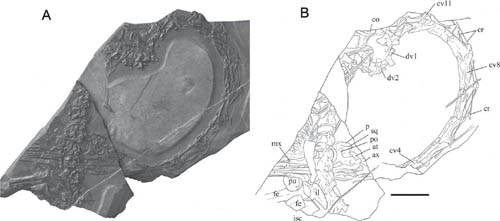New Protorosaur Found From the Middle Triassic of Southern China
Protorosaur was a diverse marine reptile group characterized by long necks and elongated neck vertebrae bearing cervical ribs that extend across at least two intervertebral joints. The constitution of the protorosaurs is very unclear. In a study published in the Journal of Vertebrate Paleontology 33(5), paleontologists from Institute of Vertebrate Palaeontology and Palaeoanthropology (IVPP), Chinese Academy of Sciences, National Museums Scotland and Field Museum of Natural History, described a new protorosaur, Fuyuansaurus acutirostris, gen. et sp. nov., from the Ladinian of southern China. This new species adds to the growing diversity and disparity of protorosaur taxa from the Middle Triassic of southern China.
The new protorosaur was found in the Zhuganpo Member of the Falang Formation at Jiyangshan (near Huabi), Fuyuan County of Yunnan Province, China. Other protorosaurs occurring in the Zhuganpo Member include Tanystropheus and the terrestrial form Macrocnemus, along with a wide variety of additional marine reptiles and a very diverse fish fauna.
Although it has been greatly crushed, the new specimen preserves the back two-thirds of the skull, part of the cervical and dorsal axial skeleton, and the majority of both the pectoral and pelvic girdles. However, practically all the limbs and tail are missing. It possesses a neck that is longer than the trunk and is similar to tanystropheids in having 12 or 13 cervicals. Unusual among protorosaurs, the new form has an elongate snout. It also lacks a clear thyroid fenestra, although there is a slight separation of the pubis and ischium close to the pubic symphysis. Fuyuansaurus acutirostris is a further addition to a host of unusual tetrapods that populated the Middle Triassic seas of the eastern Tethys.
Fuyuansaurus acutirostris was a small protorosaur with a pronounced elongate rostrum compared with all other protorosaurs. The numerous needle-like teeth might be indicative of a diet of crustaceans and fish.
"The relatively large orbit and lack of complete fusion between the neural arches and centra of the dorsal vertebrae indicate that this may be an immature individual. The new form represents one more protorosaur within the Xingyi Fauna that exhibits some quite unexpected departures from the typical suite of protorosaurian characters", said lead author Dr. Nicholas C. Fraser, National Museums Scotland.
This study was supported by the National Natural Science Foundation of China. 
Fig.1 Holotype of Fuyuansaurus acutirostris (IVPP V17983). A, complete specimen as preserved; B, line drawing of the skeleton. Scale bar equals 20 mm. (Image by Nicholas C. Fraser) 
Fig.2 A protorosaur at hunting. (Image by CPF)
Download attachments: